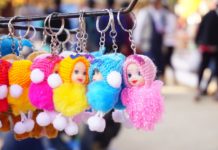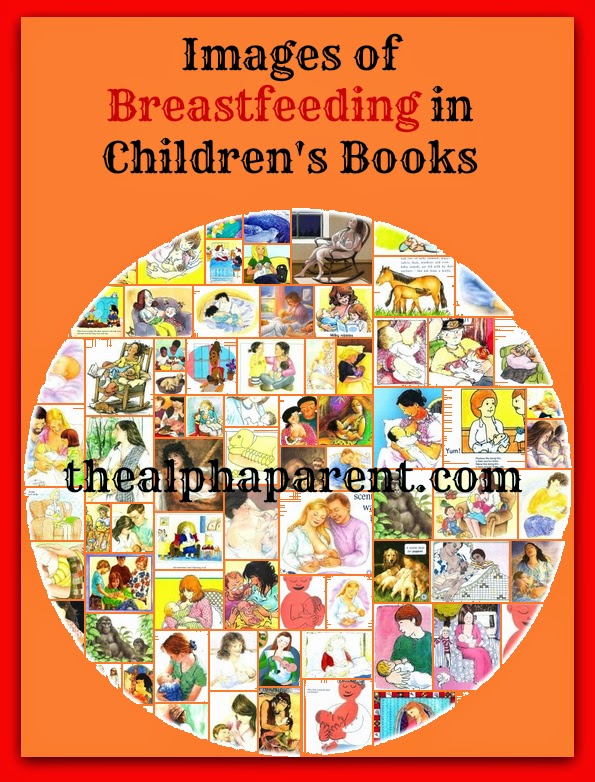(Following on from Part One, Part Two, Part Three, and Part Four).
Supermum
Mick Manning and Brita Granstrom

This quasi-nonfiction book describes the mothering behaviour of various inhabitants of the animal kingdom. The authors have taken factual textbook-style information and presented it in an easily accessible rhyming format for young children. Endearing illustrations show animals engrossed in various parenting activities alongside their human counterparts undertaking the same activities. For instance, the text informs us that: “Supermum will do anything for her little ones; She’ll go out in a storm to get her baby food”. The accompanying illustration shows an emperor penguin trekking through a ferocious snowstorm. The opposite page features an illustration of a human mother braving a similarly brutal snowstorm on the high street whilst lugging armfuls of supermarket bags. You have to smile at the tweeness. However at one point the book becomes presumptive: “We call the person who gave birth to us ‘mum’; We call the grownup who takes care of us ‘mum,’ too”. Admirably the intention was to recognise adoptive mothers, however what if “the grownup who takes care of us” is male? What about stay at home dads? What about single fathers? Gay fathers? However with regard to breastfeeding, the book does not disappoint. The text gleefully informs us that “Supermum is wide awake! Even on the darkest night, she’s always ready to feed her hungry babies”. Cue an illustration of mother in fetching pink pyjamas nursing sleepily.
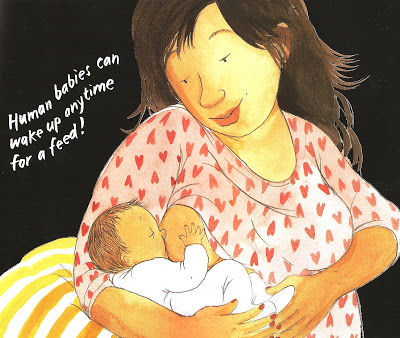
Mothers Are Everywhere
Karen Wallace and David Axtell

“From the smallest mouse to the biggest elephant, every mother does her best to look after her baby”, or so beams the blurb of this book. Stunning watercolour paintings of human and animal mothers accompany non-fiction text. The narrative describes various parenting acts, drawing parallels between the human and animal kingdom. I chose to review this book alongside ‘Supermum’ (above) as much of the content is mirrored. The page layout is the same, with human mothers on the left and animal mothers on the right. Many of the parenting acts are also the same, including baby-wearing, playing, feeding, bathing, cuddling, and home-making. There are a few original additions, for instance, babysitting: “Mother giraffes help one another by looking after each other’s babies. Everyone needs a break sometimes!” Breastfeeding is shown when a human mother nurses her baby on the left page alongside a mother seal suckling her pup on the right page. The identical features shared between this book and ‘Supermum’ make choosing a favourite difficult. For those whom favour art, ‘Mothers Are Everywhere’ reigns supreme. However if comedy is your cuppa, ‘Supermum’ is a sure bet.

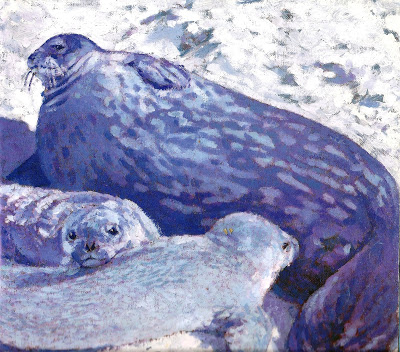
The World is Full of Babies
Mick Manning and Brita Granstrom
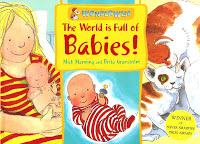
From the same author-illustrator team that created ‘Supermum’, this book unsurprisingly uses the same formula of animal and human comparison. However unlike ‘Supermum’ and its mimicker ‘Mothers Are Everywhere’, this book begins with the developing embryo. A fascinating double page spread depicts human, kangaroo, bird, whale, crocodile and frog embryos. It’s interesting to examine the similarities and differences between them. The animals’ respective lengths of utero gestation are also compared. Next, we see how sibling rivalry is not unique to humans; the first thing a cuckoo chick does when it is born is push the other eggs out of the nest. Other facets of babyhood are explored including crying, feeding, sleeping, baby-wearing, bathing, playing, learning to walk and learning to talk. Although there are many similarities, this book is an excellent companion to ‘Supermum’ as it goes into more depth. For instance, when examining feeding, a double page spread shows a human mother nursing. Alongside her, a seal and a pig mother are suckling their young. The text draws parallels between the different species, uniting them as mammals.

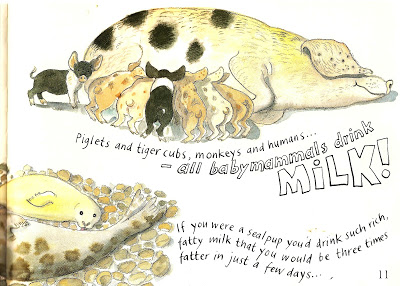
The First Family
Michael Twinn
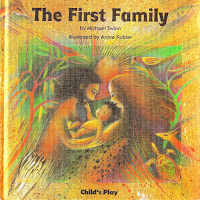
The First Family is a beautifully illustrated book with thick card pages and textured hardback cover. Illustrations in the form of tactile cave drawings add to the book’s primordial mood. Haunting text encourages the reader to ponder the origins of love and family by looking at prehistoric people. The narrative is littered with questions, the answers to which are purposively left to the reader to devise. For instance, “Was the first woman big or small? Smooth or hairy? Fair or dark?” Gradually the text moves from the meeting of the first man and woman, to their pregnancy, and through to childrearing. The prudish among you may buckle at the text’s probing of the man and woman’s first sexual experience: “Did they like each other? Were they rough or gentle? Did they know what they did?” The accompanying illustration shows a cave drawing of the first man and woman exploring each other’s nakedness. The page is also decorated with various animals copulating (I know what you’re thinking, ‘Why didn’t she scan that page?’) The next page reveals that the woman is now heavily pregnant. “Did the woman know she was carrying a child?” the text ponders. This is followed swiftly by the birth: “When the first child was born, did the woman know where it came from? Was she alone or were others present? Was she helped by other women?” The illustration shows the woman pulling a screaming baby from her neither regions, cord intact. Despite the arguable brutality of the subject nature, the drawings manage to retain a sense of gracefulness. They are perfectly complimented by the text which delicately explains that the first child was helpless, it cried for its mother, it felt her skin, her face was the first thing it saw, and then the child nursed: “It’s mother felt its need and fed it…and loved it”. A beautifully serene illustration depicts the first woman nursing the first child, accompanied by images of animals sucking their young. The remainder of the book sees the man return to the woman and discover his child. Then in an effort to counter the thus far exclusive portrayal of the traditional nuclear family, the text sensitively encourages us to consider that each family is unique, and that some children do not have a mother and a father. If you’re looking for an unconventional, touching and multifaceted children’s book about reproduction and family life, The First Family will not disappoint.



Contemplating Your Bellybutton
Jun Nanao and Tomoko Hasegawa
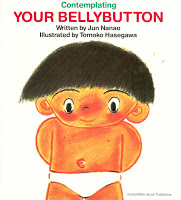
This Japanese book, translated into English, is about a boy’s thoughts regarding his bellybutton. A book all about a boy’s bellybutton, you say? That must be riveting. Of course the bellybutton theme is just a smokescreen for the true focus of the book which is the umbilical cord and infant growth. The narrative explains that a mother and baby are first joined by an umbilical cord and that this union enabled the baby to grow. After the birth, the mother-baby union continues with breastfeeding: “Even though the cord was cut, it was all right. Now you sucked milk from your mother’s breast and grew bigger” the text reassures. Anime-style crayoned illustrations show infant growth from embryo to toddler. The birth scene is a wonder to behold. We get a top down view of the mother with bulbous protruding breasts pulling her screaming baby from her neither regions in an unapologetically sensationalist style similar to that seen in ‘The First Family’. Suffice to say that nakedness is celebrated in this book. Most of the illustrations feature someone either half naked or stalk naked. Along with the naked birth scene, there’s the naked foetus in utero, naked newborn, naked boys and girls holding hands, naked Mum and Dad, and finally, that familiar household scene, the post-bath dripping wet naked toddler being chased by his mother. To conclude the book, after explaining the importance of good bellybutton care, the narrative ends abruptly with: “Now cover up… sleep well… sweet dreams”. This humorous, slightly-eccentric book would make a worthy conversational piece at dinner parties.
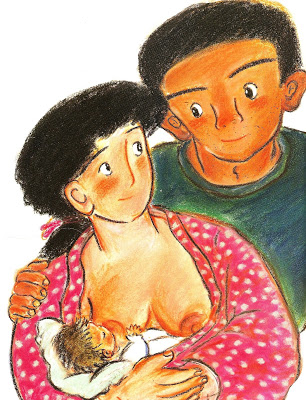
Babies, Babies, Babies
Tessa Dahl
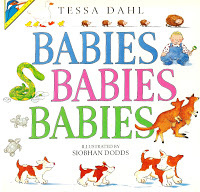
A new baby is due, and like all irritatingly inquisitive toddlers, Sophie and Sam have lots of questions to ask. ‘Babies, Babies, Babies’ is written as a conversation between the children and their pregnant mother, who must be exhausted and, I would imagine, a little pissed off from all the questions. She tells her children all about the new baby by making comparisons with other baby animals and their mothers. In this way, the book is reminiscent of ‘Supermum’ reviewed above, but sadly without much of that book’s endearing qualities. The illustrations are not as charming or as expressive and the bland monotone text does not do justice to the subject matter. This book has great scope for exploring breastfeeding, as most of the animals featured are mammals, and yet the topic is only broached tentatively. Over the breakfast table the children ask, “Will our baby eat toast and jam?” and their mother answers in predictable politically correct fashion, “Oh no, new babies can only drink milk, either from their mother’s breast or from a bottle”. The narrative continues to explain that lots of animals are fed milk from their mothers rather than from a bottle. An accompanying illustration shows a mare nursing her foal. The rest of the book covers a comprehensive array of baby-related topics: pregnancy, birth, growth, parenting, sleep, learning to walk and so on. Saving the book from being a complete disappointment is the addition of numerous fascinating facts. For instance, did you know that baby hedgehogs are born without spikes but grow ones in a few hours; or that fish never sleep; and the parents of baby turtles desert them. Time to re-evaluate all that Disney taught us as children.

What’s Inside Your Tummy Mummy?
Abby Cocovini

If we thought ‘Let’s Talk’ (reviewed in Part Four) was shy on feeding content, this book has even less information. Instead, the primary focus is the pregnancy timeline. Young kids love ‘lift the flap’ books, and the topic of pregnancy lends itself to this gimmick. Each page shows the pregnant woman’s growing body and there are some flaps to lift (Shhhush your dirty mind, I don’t mean those kind of flaps). The illustrations have realistic scale and are accompanied by interesting facts. For instance, without my sounding like a smart arse, did you know that for the first four weeks gestation, the embryo doubles in size every day? Or did you know that at four months gestation the foetus does a wee fifteen times a day? Aside from these titbits, ‘What’s In Your Tummy Mummy’ is the same old pregnancy formula. There’s very little in the way of originality. Fruit is used to demonstrate the size of the foetus at each stage. Then, on the final page the baby is born. The text explains that: “The baby is hungry all the time! It eats about 9 meals a day. But it only ever has milk!” A small illustration shows a mother discreetly breastfeeding. A large collection of bottles can also be seen. If you’re looking for a more original and pro-breastfeeding flap book on pregnancy, I recommend the next book…
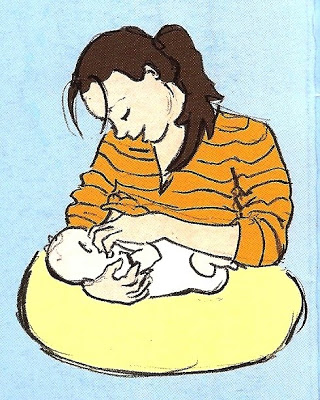
See How You Grow
Patricia Pearse and Edwina Riddell
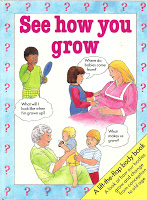
This book is a verifiable feast of flaps. Along with the predictable ‘lift the flap on the mother’s tummy to reveal the growing foetus’, the book has flaps situated in ingenious ways. There’s a bedroom door to open and a vintage locket to unlock. One flap reveals a baby going from a crawling to a standing position. Another flap shows a girl covering her mouth, and when her hand is lifted you discover that she has a missing tooth. The book explores the topic of growth in various forms – growth in utero, growth from baby to toddler, how cells divide, how food enables us to grow, the role of hormones, the influence of genetics, puberty and finally, old age. To demonstrate how hormones work, the book uses the metaphor of a motorbike currier carrying messages from head office (the brain) to tell different people (limbs and organs) what to do. Detailed illustrations show a stereotypically white, married, middle class family setup, although there are a few token black people as background detail. One full-page illustration depicts a mother happily breastfeeding whilst her husband and older child watch adoringly. The text explains that: “He is sucking milk from his mother’s breast; feeding on the milk will help him to go on growing”. There is no mention of bottle-feeding.
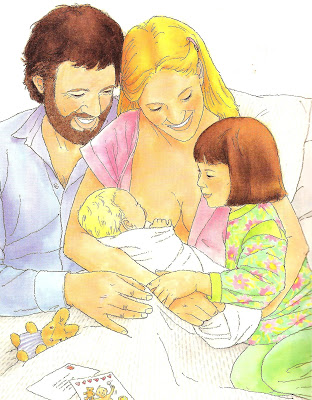
Mama’s Milk
Michael Elsohn Ross
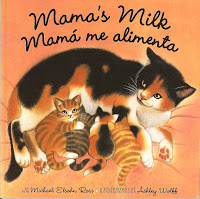
This is perhaps the most famous pro-breastfeeding children’s book to date. Gentle rhyming text guides the reader through a non-fiction exploration of the warm and loving bond between mammal mamas and their babies. The first page reads: “Cuddle little baby warm and tight – Mama’s going to feed you day and night”. These words are accompanied by a beautiful watercolor illustration of a mother nursing her baby in bed. The book goes on to show illustrations of various species nursing their young in their natural habitats – farm animals, wild animals, domestic animals and sealife, each painted in lavish detail. When humans are involved, they are shown in various ethnicities. Images include breastfeeding in public and babywearing. At the back of the book there are some extra pages depicting facts about animals and their nursing patterns. For instance, did you know that bear cubs nurse while the mother bear sleeps through the winter; elephants nurse for up to 5 years; and kangaroo milk is pink! (Yes, another book which enables you to be a smart arse). An unfortunate flaw of the book lies in its bilingual approach. The book is written in English text with Spanish text alongside. However the Spanish sentences do not correlate to the English sentences in most of the pages. They are nonetheless poetic and endearing.


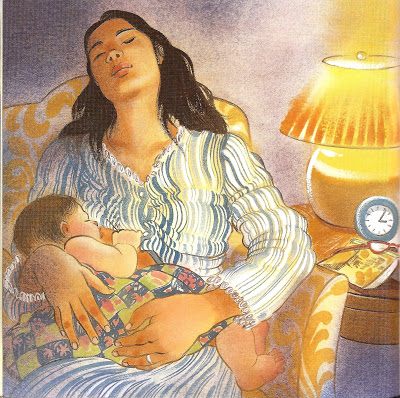
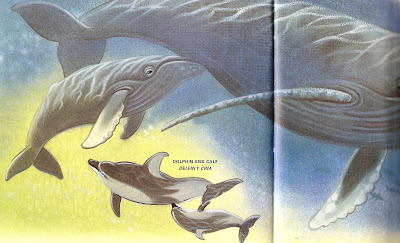
My Mommy’s Warmth
Anna Turner

My Mommy’s Warmth is an attachment parenting book depicting the growing bond between mother and baby. It achieves the feat of perfect harmony between expressive narrative and detailed endearing illustrations. From first uterine contraction through to extended breastfeeding, we watch as a new Mum and her infant develop their unique and enduring relationship. All the elements of a quality attachment parenting book are present including a gentle birth, the environment of which is left purposely vague so as to suggest either a hospital or home setting, skin to skin, breastfeeding, babywearing, a supportive involved husband, babyled weaning and co-sleeping. Expressive watercolour illustrations share snapshots of family life including singing, nappy changing, playing and public breastfeeding, both with and without a nursing cover. My favourite painting depicts the ‘milk drunk’ grin that nursing mothers are so often rewarded with. The fascinating properties of breastmilk are also mentioned, such as its distinctively sweet taste, ability to build a thriving child, and the capacity to calm and offer pain relief. Similar to ‘Mamma’s Milk’ (reviewed above), gentle rhyming text flows through the pages of this book: “When I get tired and it’s time to rest, Next to Mommy and Daddy is where I sleep best. So close to their hearts I feel blessed”. The text tinkers on the edge of the overly sentimental approach adopted by ‘The Mystery of the Breast’ (reviewed in Part Four) without reaching its nauseating depths. I would recommend this book as one of the best of the recent pro-breastfeeding offerings.

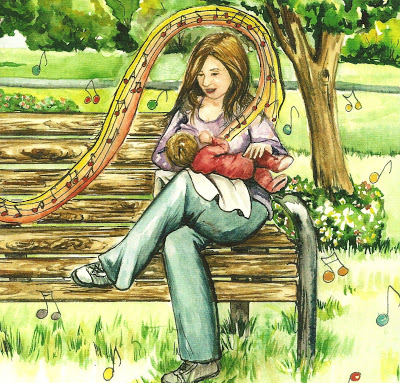
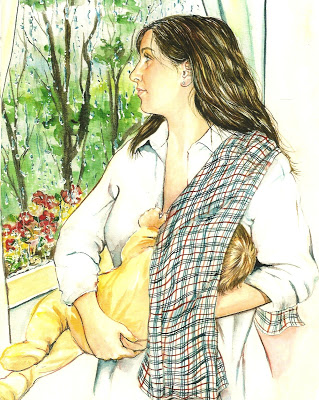
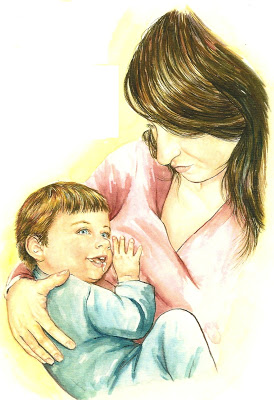
Jump to Part Six



